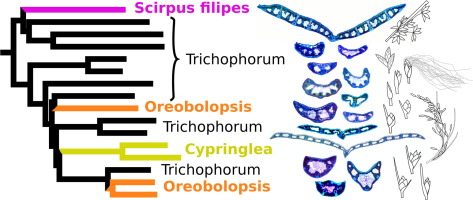当前位置:
X-MOL 学术
›
Mol. Phylogenet. Evol.
›
论文详情
Our official English website, www.x-mol.net, welcomes your feedback! (Note: you will need to create a separate account there.)
RAD sequencing resolves the phylogeny, taxonomy and biogeography of Trichophoreae despite a recent rapid radiation (Cyperaceae).
Molecular Phylogenetics and Evolution ( IF 4.1 ) Pub Date : 2019-12-30 , DOI: 10.1016/j.ympev.2019.106727 Étienne Léveillé-Bourret 1 , Bing-Hua Chen 2 , Marie-Ève Garon-Labrecque 3 , Bruce A Ford 4 , Julian R Starr 1
Molecular Phylogenetics and Evolution ( IF 4.1 ) Pub Date : 2019-12-30 , DOI: 10.1016/j.ympev.2019.106727 Étienne Léveillé-Bourret 1 , Bing-Hua Chen 2 , Marie-Ève Garon-Labrecque 3 , Bruce A Ford 4 , Julian R Starr 1
Affiliation

|
Trichophoreae is a nearly cosmopolitan Cyperaceae tribe that contains ~17 species displaying striking variation in size, inflorescence complexity, and perianth morphology. Although morphologically distinct, the status of its three genera (Cypringlea, Oreobolopsis and Trichophorum) is controversial because recent phylogenetic studies have suggested they might not be reciprocally monophyletic. However, previous analyses have shown conflicting topologies and consistently poor support due to an initial rapid diversification of the tribe. We analysed restriction-site associated DNA sequencing (RADseq) data from nearly all species of the clade, combined with five Sanger-based markers (matK, ndhF, rps16, ETS-1f, ITS) sampled extensively within species. This approach allowed us to resolve deep and shallow relationships within Trichophoreae for the first time, despite an anomaly zone spanning several successive short branches that produced considerable gene tree incongruence. Analyses reveal a primary phylogenetic split of the tribe into two clades roughly corresponding to an East Asian-North American disjunction that dates back to the mid-Miocene, with both clades comprised of a mixture of reduced unispicate and larger taxa with highly compound inflorescences. Morphological characters traditionally used in the circumscription of Trichophoreae genera are shown to be homoplasious. Several of these characters correlate best with climatic conditions, with the most reduced species occurring in open habitats at high latitudes and altitudes. Close relatives with highly compound inflorescences are found in temperate or subtropical forest understories. Cypringlea and Oreobolopsis are deeply nested within Trichophorum, and we merge all three genera into a more broadly circumscribed Trichophorum. We also show that Scirpus filipes is another previously unrecognized East Asian species of Trichophorum with highly compound inflorescences.
中文翻译:

尽管最近有快速放射(莎草科),但RAD测序仍能解决毛癣菌的系统发育,分类学和生物地理学问题。
Trichophoreae是一种近乎世界化的莎草科部落,其中包含约17种物种,在大小,花序复杂性和花被形态上都表现出惊人的变化。尽管在形态上是不同的,但其三个属(Cypringlea,Oreobolopsis和Trichophorum)的状态仍存在争议,因为最近的系统发育研究表明它们可能不是单亲的。但是,先前的分析表明,由于部落最初的快速多元化,拓扑结构相互矛盾且支持始终不佳。我们分析了几乎所有进化枝物种的限制性位点相关DNA测序(RADseq)数据,并结合了在物种内广泛采样的五个基于Sanger的标记(matK,ndhF,rps16,ETS-1f,ITS)。尽管跨越几个连续的短分支的异常区域产生了可观的基因树不一致,但这种方法使我们首次解决了毛癣菌内的深层和浅层关系。分析表明,该部落的系统发育初步分为两个进化枝,大致对应于中新世中期的东亚-北美分离作用,两个进化枝均由减少的不明显的和较大的类群与高度复合的花序组成。传统上在毛癣菌属的环切中使用的形态特征被证明是同质的。这些特征中的几个与气候条件最相关,减少的物种最多出现在高纬度和高海拔的开放栖息地中。在温带或亚热带森林林下发现了具有高复合花序的近亲。Cypringlea和Oreobolopsis深入嵌套在Trichophorum中,我们将这三个属合并为一个更广泛限制的Trichophorum。我们还表明,Scirpus filipes是另一种以前未被认可的东亚毛癣菌,具有很高的复合花序。
更新日期:2019-12-30
中文翻译:

尽管最近有快速放射(莎草科),但RAD测序仍能解决毛癣菌的系统发育,分类学和生物地理学问题。
Trichophoreae是一种近乎世界化的莎草科部落,其中包含约17种物种,在大小,花序复杂性和花被形态上都表现出惊人的变化。尽管在形态上是不同的,但其三个属(Cypringlea,Oreobolopsis和Trichophorum)的状态仍存在争议,因为最近的系统发育研究表明它们可能不是单亲的。但是,先前的分析表明,由于部落最初的快速多元化,拓扑结构相互矛盾且支持始终不佳。我们分析了几乎所有进化枝物种的限制性位点相关DNA测序(RADseq)数据,并结合了在物种内广泛采样的五个基于Sanger的标记(matK,ndhF,rps16,ETS-1f,ITS)。尽管跨越几个连续的短分支的异常区域产生了可观的基因树不一致,但这种方法使我们首次解决了毛癣菌内的深层和浅层关系。分析表明,该部落的系统发育初步分为两个进化枝,大致对应于中新世中期的东亚-北美分离作用,两个进化枝均由减少的不明显的和较大的类群与高度复合的花序组成。传统上在毛癣菌属的环切中使用的形态特征被证明是同质的。这些特征中的几个与气候条件最相关,减少的物种最多出现在高纬度和高海拔的开放栖息地中。在温带或亚热带森林林下发现了具有高复合花序的近亲。Cypringlea和Oreobolopsis深入嵌套在Trichophorum中,我们将这三个属合并为一个更广泛限制的Trichophorum。我们还表明,Scirpus filipes是另一种以前未被认可的东亚毛癣菌,具有很高的复合花序。

























 京公网安备 11010802027423号
京公网安备 11010802027423号